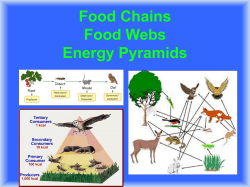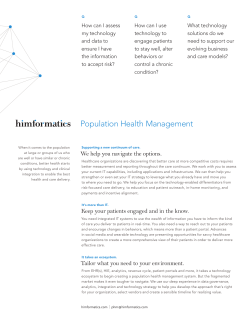
Communities go green and blue – Towards
Communities go green and blue – Towards sustainable ecosystem service management in Latin America Final Conference of the CiVi.net Project Ecosystem Service Partnership (ESP) Conference ‘Local action for the common good’ San José, Costa Rica , September 8-12, 2014 Sub-session 1 10.30 – 11.45 How civil society actors enhance community based governance for ecosystem service management? (presentation) 20 minutes Bettina Matzdorf Communities go green and blue – introduction in successful stories of community based solutions 20 minutes Claudia Sattler Multi-level governance in community-based natural resource management: a case study comparison from Latin America 20 minutes Angela Meyer, Gregor Giersch Meeting the expectations? Roles and functions of CSOs in community-based ES management 10 minutes Discussion Sub-session 2 11.45 – 12.30 Practical illustrations of community-based environmental management: analysis of successful instruments and documentation of the transfer process 45 minutes Bernardo Aguilar Community-Based Collaboration Between Local Groups González, Angela and Environmental NGOs in a Restrictive Access Rights Meyer, Bettina Situation Matzdorf 13.30– 15.00 45 minutes 45 minutes Practical illustrations of community-based environmental management: analysis of successful instruments and documentation of the transfer process Rosildo, Alex, Conflict resolution in a Brazilian State Park through Paulo, adaptive co-management Camila,Barbara Corombert Leão, Cattle Ranching, Carbon Credits and PES Tim Reutemann, Stefano Merlin, Peterson Sacconi Sub-session 2 15:30-16:15 Qualification works within the project 20 minutes Tim Reutemann Accounting and Paying for Avoided Deforestation - A Detailed Analysis of the General Problem and the Case of Cattle Ranching in Tocantins, Brazil, in Theory and Experiment 20 minutes Camila JericóDaminello Socio-cultural identification and valuation of ecosystem services - the case of Marujá community, Cardoso Island – SP, Brazil Sub-session 2 16.15 – 17.00 45 minutes Practical illustrations of community-based environmental management: analysis of successful instruments and documentation of the transfer process Bertilo Vandresen, Amilton Collaboration between researchers and Nunes, Abdon Schmitt communities in ES management: Implementing Filho, Darci Pitton Filho, the Voisin System in Santa Catarina Barbara Schröter Final Discussion 17.00-18.00 Final discussion on project CiVi.net: communities go green and blue! How to move towards sustainable ES management in Latin America? Communities go green and blue – Final Conference of the CiVi.net Project Introduction in successful stories of community based solutions Bettina Matzdorf 1 = ZALF - Leibniz-Centre for Agricultural Landscape Research, Müncheberg, Germany Ecosystem Service Partnership (ESP) Conference ‘Local action for the common good’ San José, Costa Rica , September 8-12, 2014 Focus of the CiVi.net Project 1.) Community-based ecosystem service management solutions 2.) Role of civil society actors within such kind of solutions Project Overview – Aims successful solutions for community based ecosystem service management Analysis Transfer Dissemination What kind of institutions and actors support successful ecosystem management approaches? How the actors establish goals? How actors define rules for reaching the defined goals? How actors control outcomes following from the use of these rules? Governance is about forming institutional structures. It concerns making social priorities, resolving conflicts and facilitating human coordination (cf. Paavola, 2007, Vatn, 2010). Framework for governance analysis Scalelevel of analysis Local/community level NIE: Williamson, 2000 Rules of the game - change of rules and their enforcement - - change of their roles, constellation and modes of interaction - Play of the game (by actors)! Time Community-based management Community definitions refer to a group of people, who: i) live in the same geographical area, region, landscape; ii) are co-located in the same administrative unit; iii) share a certain interest, pursuit, or occupation; iv) distinguish themselves by nationality, race, ethnicity, religion, sexuality; v) are tied by social bonds and share common values; or vi) are connected through shared ownerships in goods and property. Three basic notions: a) place vs. b) institutional structures vs. c) social interaction (SDC 2013) Our definition (draws from all three notions): Community-based management Why is it interesting to look at the community level? • : system of command and control, resource allocation according to existing power structures • voluntary exchange between individual agents, resource allocation according to their willingness to pay • cooperation!, resource allocation according to individual and common goals, community Community allocation rest to a large extent management on a general rule of reciprocity (cf. Vatn, 2010; Ostrom, 1990) Community-based management Why is it interesting to look at the community level? Community level is essential if a solution for a specific environmental problem in a specific social-cultural context . The complexity of our social-ecological system often require such kind of rules (transaction costs). Weaknesses of hierarchy and market rules can require such kind of rules. Community People will only develop and accept such kind of voluntary rules if solutions improvedmanagement livelihoods and nature conservation goals and the issue of equity is considered. Identification of our Case Studies • Latin America • Community-based approaches are essential part of the solution (the governance type) • Civil society actors involved How did we find our successful solutions? Our CSO partners suggested successful solutions. CiVi.Net Case Studies – Our successful Stories Community-based solutions -> improved livelihoods + conservation: • Marujá: Management plan (‘nogrow’ strategy, eco-tourism) • Santa Catarina: Improved grassland management (Voisin system) Santa Catarina • Tocantins: Energy source switch ceramic industries (native firewood to rice husk, SOCIALCARBON®) • Osa: Blue carbon (mangrove reforestation, environmental education, community capacitation) CiVi.Net Case Studies – Our successful Stories Hierarchies Marujá Community management Markets CSO: AMOMAR (community organisation) Land ownership situation: Public owned land, restrictive access rights CiVi.Net Case Studies – Our successful Stories Hierarchies Santa Catarina Community management Markets CSO: Voisen Group (intrinsic motivated Researcher) + farmer association Land ownership situation: Private land CiVi.Net Case Studies – Our successful Stories Hierarchies Markets CSO: Tocantins Community management EI (NGO) + Sustainable Carbon Ownership situation: Private CiVi.Net Case Studies – Our successful Stories Hierarchies Markets Osa Community management CSO: NEO (NGO) + ACOPES Ownership situation: Public owned land, restrictive access rights Hybrid forms of governance in our case studies Hierarchies Markets Osa Marujá Tocantins Santa Catarina Community management Contact: Bettina Matzdorf P: +49 (0) 33432 82-439 E: matzdorf@zalf.de W: www.zalf.de / www.civinet.eu
© Copyright 2025










